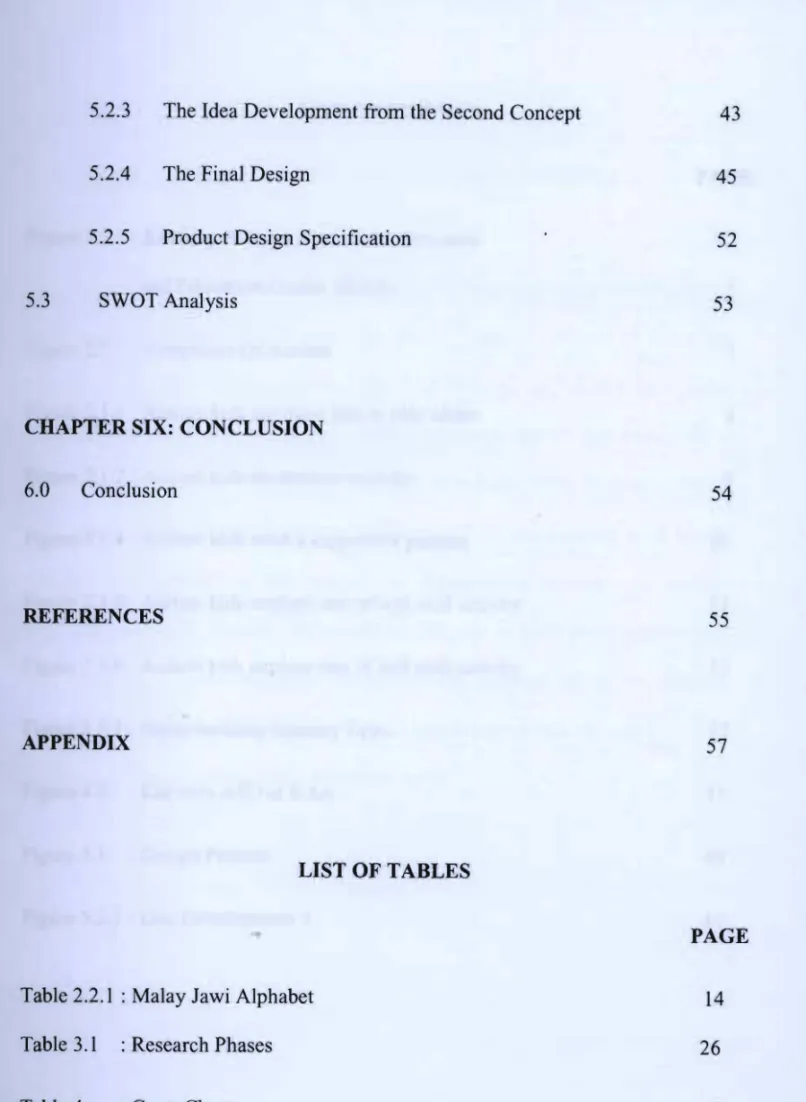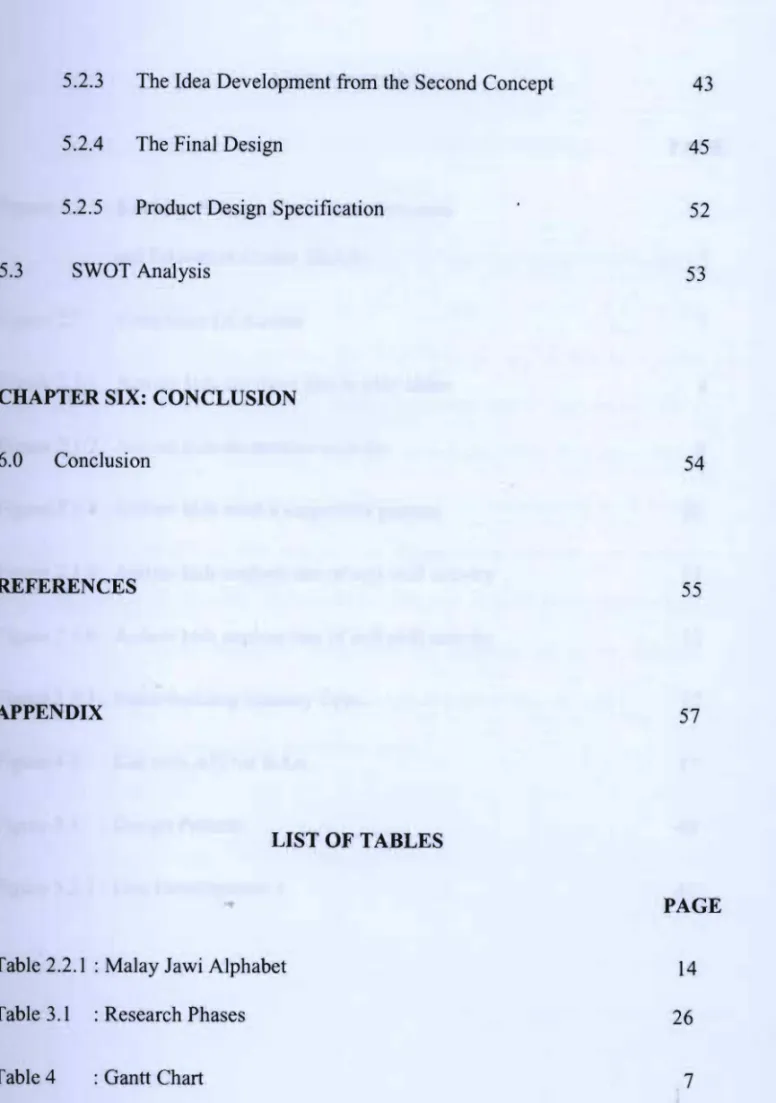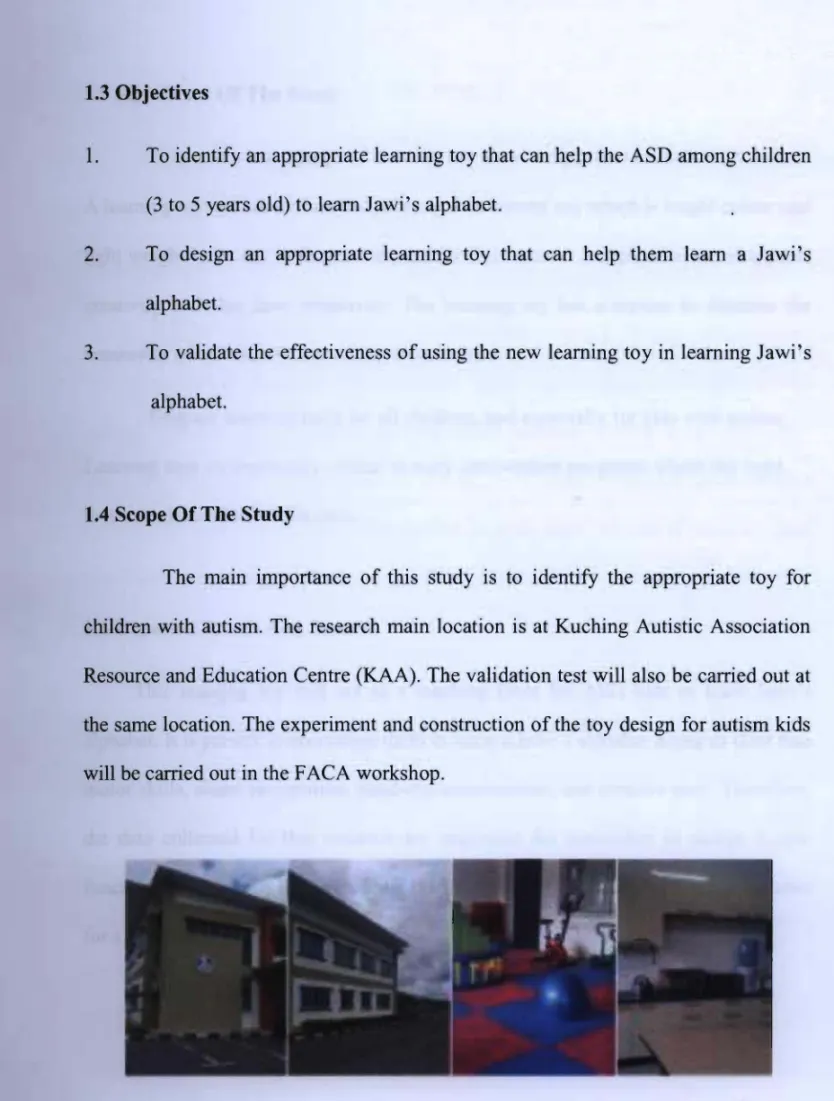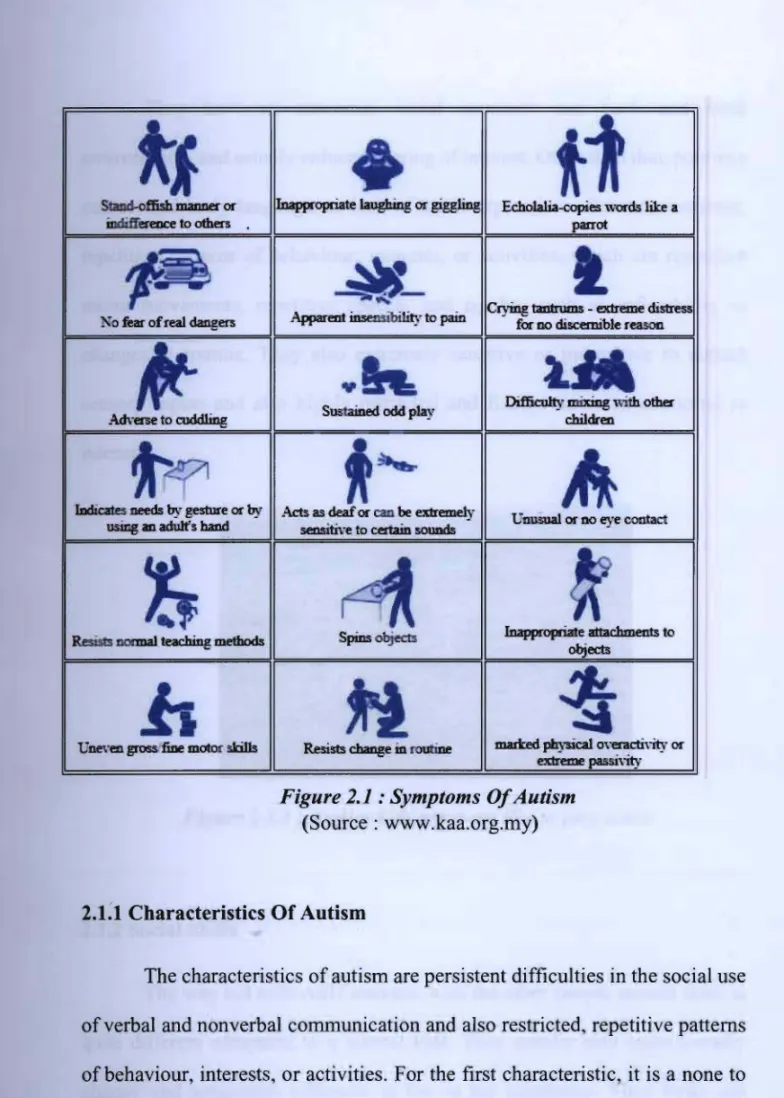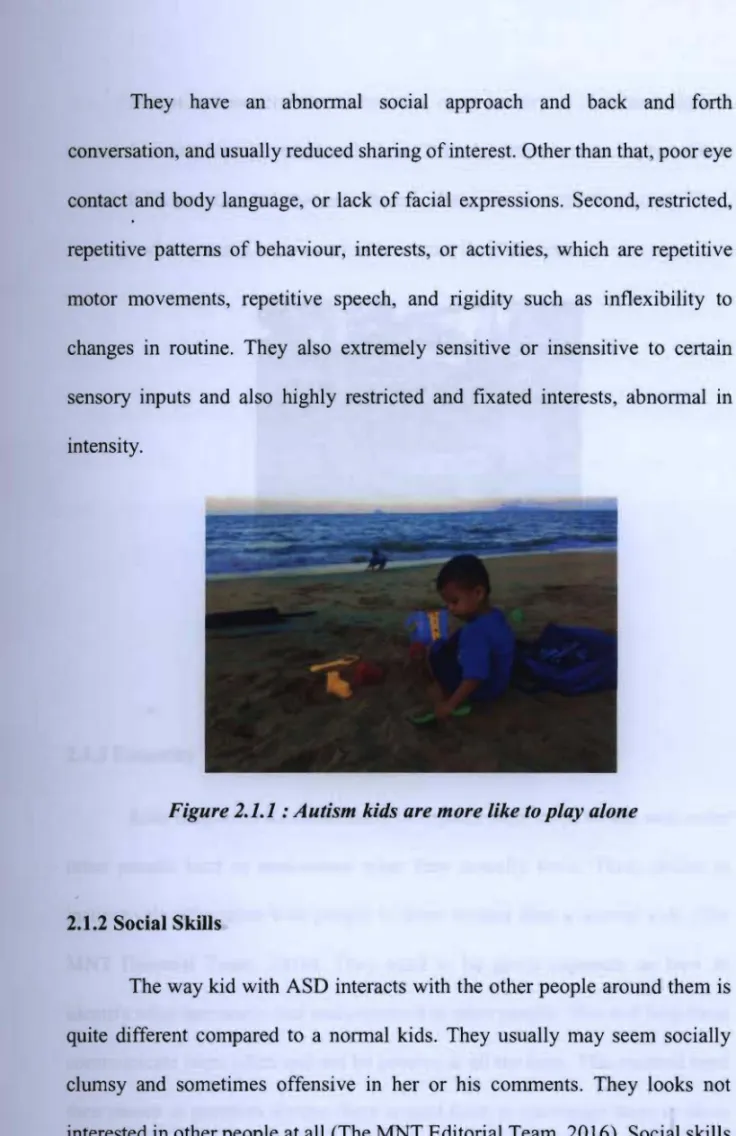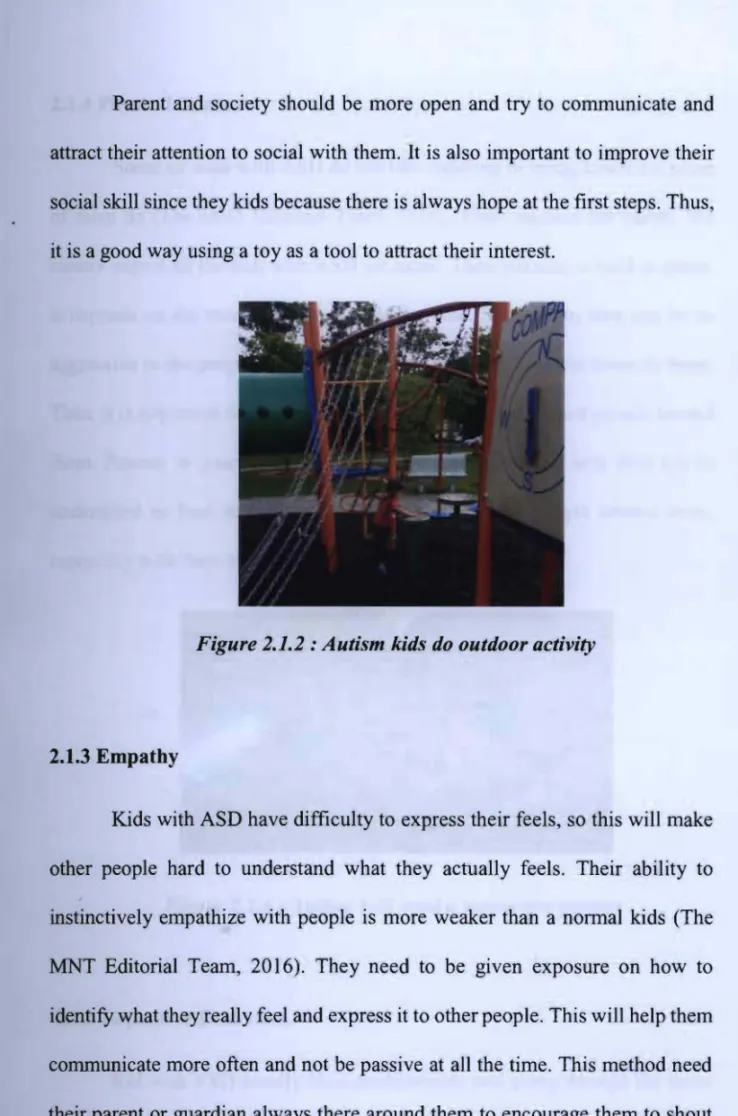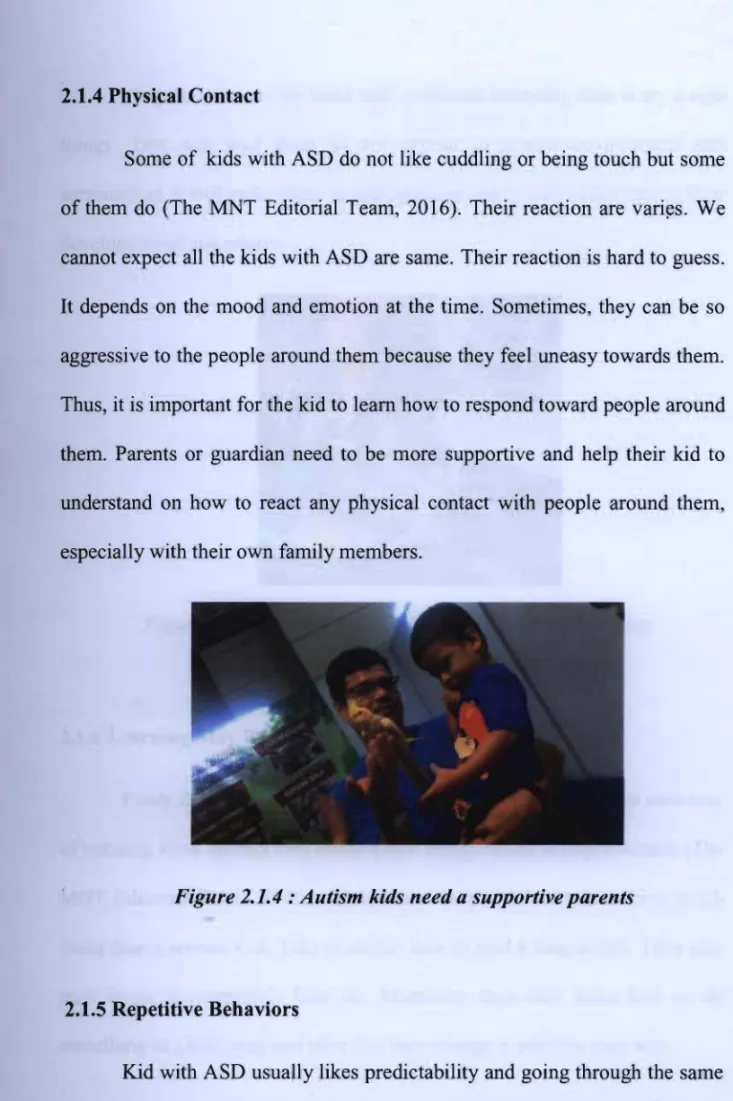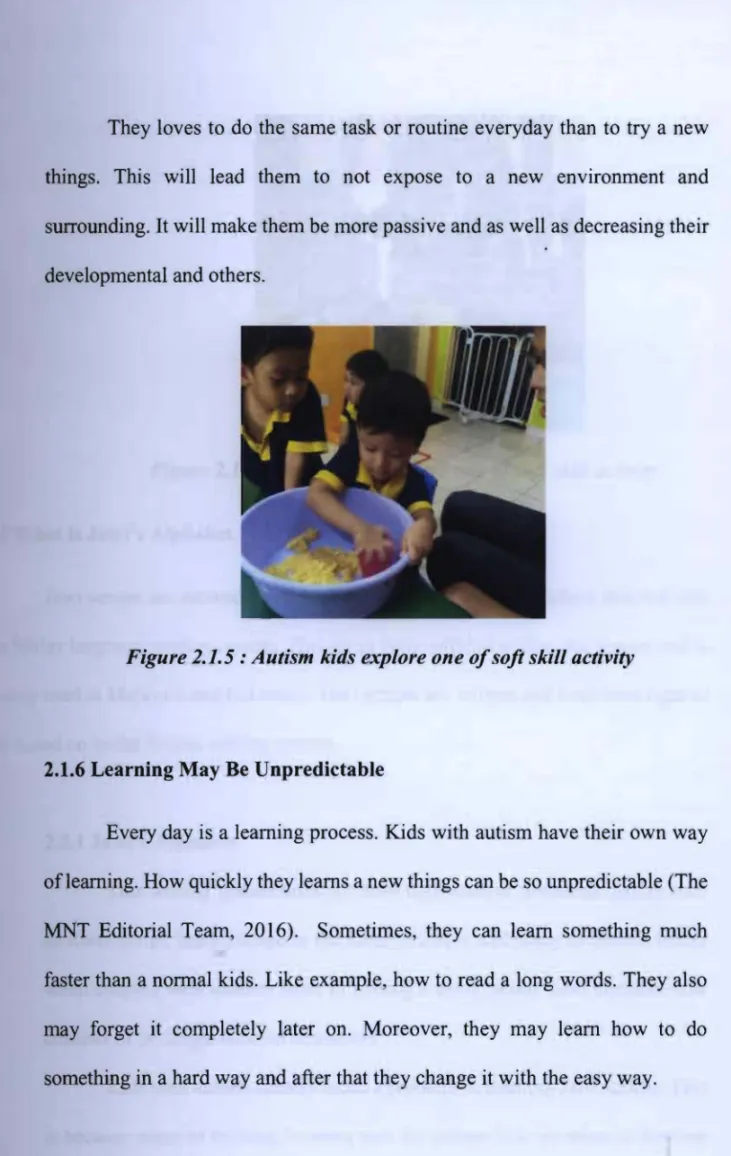JAWI LEARNING TOY FOR AUTISTIC CHILDREN
Noor Aisha Binti Arifin
Bachelor of Applied Arts with Honours (Design Technology)
2019
JAWI LEARNING TOY FOR AUSTISTIC CHILDREN
NOOR AISHA BINTI ARIFIN
This project is submitted in partial fulflJllment of
the requirements for the degree of Bachelor of AppJied Arts with Honours (Design Technology)
Faculty Of Applied And Creative Arts UNIVERSITI MALAYSIA SARA W AK
2019
UNlVERSITI MALAYSIA SARAW AK
)
Grade: ~_It-c-
__
Please tick ( )
Final Year Project Report
[2]
Masters
r=J
PhD
1 c====J
DECLARATION OF ORIGINAL WORK This declaration is made on the ... ~.?:-.. .. day of ... ~~~... .. 2019.
Student's Declaration:
I, NOOR AISHA BINTI ARIFIN (56980) FACULTY OF APPLIED AND CREATIVE ARTS hereby declare that the work entitled JAWI LEARNING TOY FOR AUSTISTIC CHILDREN is my original work. I have not copied from any other students' work or from any other sources except where due reference or acknowledgement is made explicitly in the text, nor has any part been written for me by another person.
Date submitted Noor Aisha binti
Arifin (56980) Supervisor's Declaration:
I, DR. FARIDAH BINTI SAHARI hereby certifies that the work entitled JAWI LEARNING TOY FOR AUSTISTIC CHILDREN was prepared by the above named student, and was submitted to the FACULTY OF APPLIED AND CREATIVE ARTS as a * partial/full fulfillment for the conferment of BACHELOR OF APPLIED AND CREATIVE ARTS WITH HONOURS (DESIGN TECHNOLOGY), and the aforementioned work, to the best of my knowledge, is the said student's work.
Date: ~~ Cl\9 1 ~0\' Dr Faridah binti Sahari
I declare that Project/Thesis is classified as (Please tick C,f)):
c=::J
CONFIDENTIAL (Contains confidential information under the Official Secret Act 1972)*c=::J
RESTRICTED (Contains restricted information as specified by the organisation where research was done)*CZJ
OPEN ACCESSValidation of Project/Thesis
I therefore duly affirmed with free consent and willingness declare that this said Project/Thesis shall be placed officially in the Centre for Academic Infonnation Services with the abiding interest and rights as follows:
• This ProjectlThesis is the sole legal property ofUniversiti Malaysia Sarawak (UNIMAS).
• The Centre for Academic Information Services has the lawful right to make copies for the purpose of academic and research only and not for other purpose.
• The Centre for Academic Information Services has the lawful right to digitalise the content for the Local Content Database.
• The Centre for Academic Information Services has the lawful right to make copies of the ProjectlThesis for academic exchange between Higher Learning Institute.
• No dispute or any claim shall arise from the student itself neither third party on this ProjectlThesis once it becomes the sole property of UN1M AS.
• This ProjectlThesis or any material, data and infonnation related to it shall not be distributed, published or disclosed to any party by the student except with UNIMAS pennission.
Student signature ___
~--:::J
;:::;.,if;;;.=-- -- Supervisor signature: - -___2<--- A
Noor Aisha binti Arifin (56980 ) Dr Faridah binti Sahari Current Address:
NO 2015 Blok 11 Jln Bestari, Felda Lok Heng Timur.
81900 Kota Tinggi, Johor.
Notes: * If the ProjectIThesis is CONFIDENTIAL or RESTRICTED, please attach together as annexure a letter from the organisation with the period and reasons of confidentiality and restriction.
[The instrument is duly prepared by The Centre for Academic Information Services]
11
The project entitled'JAWI LEARNING TOY FOR AUSTISTIC CHILDREN' was prepared by Noor Aisha binti Arifin and submitted to the Faculty of Applied and Creative Arts in partial fulfillment of the requirements for a Bachelor of Applied Arts with Honours (Design Technology).
Received for examination by:
(Dr Faridah binti Sahari)
Date:
III
ACKNOWLEDGEMENT
Bismillahirahmaniraliim ...
I would like to take this opportunity to express my gratitude and appreciation to all the people who have helped and guided me in completing this final year project.
First of all, 1 would like to give special thanks to my supervisor, Dr. Faridah binti Sahari for her invaluable suggestions, constructive advices and helpful comments throughout the process of completing the course of this study. I am kindly appreciated for her precious time and efforts devoted to supervise me. The continuous suggestions and ideas has guided me toward the accomplishment of this project. I have learned and gained a lot of knowledge from her in doing this research.
Secondly, I am grateful to my beloved family and friends for the moral support and encouragement all the way in my journey of studying an undergraduate degree in Universiti Malaysia Sarawak (UNIMAS). I wish to express my words of appreciation to those who read and share their knowledge and opinions with me about this project.
Third, I am so thankful to Kuching Autisme Association for willing to shared so much experiences and information about Autism.
Last but not least, I would like to extend my sincere thankful to all the lecturers and staffs of the Faculty of Applied and Creative Arts and The Centre for Academic Information Services (CAIS) for their kind dedication and resources provided to me to complete my project.
IV
T ABLE OF CONTENTS
PAGE
DECLARAnON OF ORIGINAL WORK
ACKNOWLEDGEMENT
TABLE OF CONTENTS
LIST OF TABLES
LIST OF FIGURES
ABSTRACT
ABSTRAK
CHAPTER ONE: INTRODUCTION
l.0
Introductionl.1
Problem Statementl.2
Research Questionsl.3
Objective of Study 1.4 Scope of Studyl.5
Significance of Study 1.6 Expected Result and BenefitV
LV
V
VI
XL
Xll
XVI
2 2 3 3
4
4
CHAPTER TWO: LITERATURE REVIEW
2.0 Introduction 5
2.1 Symptoms of Autism 5
2.1.1 Characteristic of Autism 7
2.1.2 Social Skills 8
2.1.3 Empathy 9
2.1.4 Physical Contact 10
2.1.5 Repetitive Behaviors 10
2.1.6 Learning May Be Unpredictable II
2.2 What is Jawi's Alphabet 12
2.2.1 Jawi's Alphabet 12
2.2.2 The Important of Learning Jawi IS
2.3 Toy for Kids with ASD IS
2.3.1 The Important of Toy for Kids with ASD 16
2.3.2 The Types of Toy That Suitable for Kids with ASD 18
CHAPTER THREE: METHODOLOGY
3.0 Introduction 24
3.1 Qualitative Approach 24
3.1.1 lntervievv
3.1.2 Observation
3.1.3 Case Study
3.2 Validation and Analysis
CHAPTER FOUR: DATA ANALYSIS AND FINDINGS
4.0 Introduction
4.1 Analysis on Methods of Data Collection
4.2 lntervievv
4.2.1 Results of ilntervievvs
4.3 Observation
4.4 Summary
CHAPTER FIVE: PROPOSED DESIGN
5.0 lntroduction
5.1 Design Analysis
5.2 Idea Development
5.2.1 The First Concept
5.2.2 The Second Design Concept
24
25
25
25
28
28
28
29
37
37
39
39
41
41
42
5.2.3 The Idea Development from the Second Concept 43
5.2.4 The Final Design 45
5.2.5 Product Design Specification 52
5.3 SWOT Analysis 53
CHAPTER SIX: CONCLUSION
6.0 Conclusion 54
REFERENCES 55
APPENDIX 57
LIST OF TABLES
PAGE
Table 2.2.1 : Malay Jawi Alphabet 14
Table 3.1 : Research Phases
26
Table 4 : Gantt Chart 7
VI
LIST OF FIGURES
PAGE
Figure 1.1 : Kuching Autistic Association Resource
and Education Centre (KAA) 3
Figure 2.1 : Symptoms Of Autism 7
Figure 2.1.1 : Autism kids are more like to play alone 8
Figure 2.1.2 : Autism kids do outdoor activity 9
Figure 2.1.4 : Autism kids need a supportive parents 10
Figure 2.1.5 : Autism kids explore one of soft skill activity 11
Figure 2.1.6 : Autism kids explore one of soft skill activity 12
Figure 2.3.1 : Brain-building Sensory Toys 17
Figure 4.3 : Kid with ASD at KAA 37
Figure 5.1 : Design Process 40
Figure 5.2.1 : Idea Development 1 41
Xl
ABSTRACT
JAWI LEARNING TOY FOR AUSTISTIC CHILDREN
The purpose of this research is to study the suitable learning toy for Autism kids to learn a Jawi's alphabet (3 to 5 years old). There is about I percent of the world population that has autism spectmm disorder (WHO,20 18). Teaching toy for learning Jawi's alphabet is still few in market. It is important to learn an alphabets since kids, especiall y J awi 's al phabet. It helps kids to know all the alphabets in their early age and also how to pronounce it correctly. Toys are teaching tools for all children, and especially for kids with autism. The learning toys can gives a huge good impact to them. Parents also usually use the toys to build good relationships with their kids. Toys can help their social skills and language. Moreover, children learn through play. The new design of toy will be more functional and can help their mental development, social skills and many more.
XVI
A BSTRAK
ALAT BANTU BELAJAR JA WI UNTUK KANAK-KANAK A UTISME
Kajian ini bertujuan untuk mengkaji apakah bentuk alat bantu belajar hurufJawi yang paling sesuai bagi kanak-kanak Autisme, ( dalam lingkungan 1I111Ur 3 hingga 5 tahun).
Menurut Pertubuhan Kesihatan Sedunia, terdapat 1 peratus orang mengalami gangguan Autisme di seluruh dunia (WHO,2018). Alat bantu belajar hurufjawi masih lagi sedikit di dalam pasaran. Pembelajaran huruf di awalusia kanak-kanak sangat penting terutama sekali hU114Jawi. Hal ini demihian kerana dapat membantu kanak
kanak untuk mengenali hurt~r Jawi di dalam peringkat llsia yang muda dan dapat menyebutnya dengan sebutan yang sempurna. Bahkan, alat permainan juga merupakan salah salu alat bantu belajar yang sangat sesuai untuk kanak-kanak Autisme. Alat permainan tersebut dapat memberikan impak yang positif kepada mereka. Selain daripada itu, kebanyakan ibu bapa tumt menggunakan alat permainan untuk mengeratkan hubungan mereka dengan anak-anak mereka. Alat permainan dapat mendorong kanak-kanak Autisme llntuk bergaul dan berinteraksi dengan orang di sekeliling mereka. Tambahanllya lag;, kallak-kanak sering belajar sesllatu yang baru ketika mereka sedang bermain. Reka bentuk alat bantu belajar hunifJawi baharu ini mempunyai ciri-ciri yang lebih sesuai iaitu dilengkapi dengan pelbagai jimgsi, serta mampu meningkatkan perkembangall mental, kemah iran sosial dan banyak lagi.
XVll
CHAPTER 1
RESEARCH BACKGROUND
1.0 Introduction
There is about 1 percent of the world population that has autism spectrum disorder.
(WHO, 2018). ADS usually can be detect since childhood and it can tend into adolescence and adulthood. Some of them can live their life independently, but some others have severe disabilities and need life-long care and support. Interventions for people with ASD especially kids need to be accompanied by broader actions for making physical, social and attitudinal environments more accessible and supportive.
(WHO, 2018). Estimated children with ASD have increased significantly in recent years in the global which is 17 per 10,000 (Elsabbagh, 2012). There is a problem that kids with autism spectrum disorder (ASD) faced especially with restricted interests, and repetitive behaviour. Despite give a medical treatment. Thus, using a suitable learning toy will be the best approach to encourage their communication, interaction and developmental abilities. In Malaysia, the learning toy mostly conceptualized based on general needs for whole world. Most of the learning toy are from overseas. Some of it doesn't fulfill a Muslims autisme kid's needs. The importance oflearning Jawi's alphabet also need to be consider as well. This research is to create a new learning toy for kids with autism to learn Jawi's alphabet. The research of validation and analysis will test by the kids with autism and the analysis will use on the data collected. The observation is by capturing photos and video camera to record their behaviour.
1.1 Problem Statement
There is about 1 percent of the world population that has autism spectrum disorder (WHO, 2018). Statistics: Autism occurs in lout of 500 live births (1 in 150 live births in some developed countries), Kuching Autistic Association. ADS usually can be detect since childhood and it can tend into adolescence and adulthood. There is a problem that kids with autism spectrum disorder (ASD) faced especially with impaired communication, restricted interests, and repetitive behaviour. Mostly, learning toy that has been existed is too general. A learning toy that has elements of
learning Jawi's alphabet are still few.
Thus, the importance oflearning Jawi's alphabet also need to be considered (especially to fulfill the muslims autism kid's needs in the form of educational toys).
1.2 Research Questions
1. How to help autism spectrum disorder among children (3 to 5 years old) to learn Jawi's alphabet?
2. Why is it important to design an appropriate learning toy which is learn a Jawi's alphabet?
3. What kind of appropriate learning toy that can help them to learn Jawi's alphabet with more fun and easily to understand?
2
1.3 Objectives
1. To identify an appropriate learning toy that can help the ASD among children (3 to 5 years old) to learn Jawi's alphabet.
2. To design an appropriate learning toy that can help them learn a Jawi's alphabet.
3. To validate the effectiveness of using the new learning toy in learning Jawi's alphabet.
1.4 Scope Of The Study
The main importance of this study is to identify the appropriate toy for children with autism. The research main location is at Kuching Autistic Association Resource and Education Centre (KAA). The validation test will also be carried out at the same location. The experiment and construction of the toy design for autism kids will be carried out in the F ACA workshop.
Figure 1.1 : Kuching Autistic Association Resource and Education Centre (KAA)
3
1.5 Significant Of The Study
To create a new design of learning toy (Jawi's alphabet) for kids with autism.
A learning toy with more function, not just as a nonnal toy whi<;h is bright colour and light weight but a toy with good impact for their mental and physical development, creativity and also their sensitivity. The learning toy has a texture to increase the sensitivity of the child to something around them.
Toys are teaching tools for all children, and especially for kids with autism. Learning toys are especially critical in early intervention programs where the right toys can make all the difference.
1.6 Expected Result And Benefit
This learning toy will act as a teaching tools for ASD kids to learn Jawi's alphabet. It is perfect to encourage them to learn a Jawi's alphabet along as their fine motor skills, shape recognition, hand-eye coordination, and creative play. Therefore, the data collected for this research are important for researcher to design a new functional learning toy that included a Jawi's alphabet. The learning toy must suitable for a Muslims autism kid needs.
4
CHAPTER 2
2.0 LITERATURE REVIEW
2.0 Introduction
Autism spectrum disorder (ASD) refers to a group of complex
neurodevelopment disorders characterized which is repetitive and characteristic patterns of behaviour and difficulties with social communication and also their daily interaction. The causes of autism are by genetic, viral infection, dysfunctional immune system, biochemical disorder, abnormalities in brain structure, and allergies or food sensitivities (wheat and milk products).
2.1 Symptoms Of Autism
The symptoms can be identified from early childhood and it affect daily tasks.
Kids with ASD experience difficulties for understand other people in terms of their emotion, beliefs, thoughts and also feelings.(Hetcher-Watson S, et.al., 2014).
Behaviour problems autism's children are like interfere with their cognitive efficacy, health, safety, socialization and also quality of their daily life (Lizbeth Escobedo, et.al 2014). Moreover, they often find themselves confused and disengaged.
Autism also refer to a complex developmental disability. Experts say that in most cases children with autism can be identified as early as one to three years. This condition affects the disruption neurological that can affecting development of the kid's communication, normal brain function, and social interaction skills (The MNT
5
Editorial Team, 2016) . Boudreau (20 I 0) stated that it is also a pervasive developmental disorder characterized by deficits in communication and interaction, repetitive behaviors and restricted.
Autism or autistic spectrum disorder (ASD) is a wide-spectrum disorder. This means that no kid will have exactly the same symptoms with the others kid, because there still have some different in how they react to something, how they thinking, communicate and socializing skills. In this situation, parents and people around them play the most important roles as a supporter and a place for them to relay on. So, relationship between family members also need to be take care. Beneficial support refers to the best possible attention (Graham,20 15).
There are varying degree of severity for this disorder and the prevalence rate is currently 1 in every 68 children. Based on previous medical research, autism disorder is about 5 times more common among boys than among girls.
6
Inappropriate laughing or giggling Echolalia-copies words lil::.e a parrot
Sustained odd play
..
IDdiate$ Deeds by gesture or by Acts as deafor can be extremely using an adults hand sensitiYe to certain SOODds
t1
Crying tantrums - extreme
l
distress for 00 discernible reasonDifficulty mixing with other children
l i'nusual. or no eye CQlltact
Inappropiate IIttachments to objects
marked physical 0\-eractivity or extreme passi\·ity
Figure 2.1: Symptoms OfAutism (Source: www.kaa.org.my)
2.1~1 Characteristics Of Autism
The characteristics of autism are persistent difficulties in the social use of verbal and nonverbal communication and also restricted, repetitive patterns of behaviour, interests, or activities. For the first characteristic, it is a none to delayed speech. They tend to having a difficulties in developing, maintaining, and understanding relationship.
7
They have an abnonnal social approach and back and forth conversation, and usually reduced sharing of interest. Other than that, poor eye contact and body language, or lack of facial expressions. Second, restricted, repetitive patterns of behaviour, interests, or activities, which are repetitive motor movements, repetitive speech, and rigidity such as inflexibility to changes in routine. They also extremely sensitive or insensitive to certain sensory inputs and also highly restricted and fixated interests, abnonnal in intensity.
Figure 2.1.1 : Autism kids are more like to play alone
2.1.2 Social Skills
The way kid with ASD interacts with the other people around them is quite different compared to a nonnal kids. They usually may seem socially clumsy and sometimes offensive in her or his comments. They looks not interested in other people at all (The MNT Editorial Team, 2016). Social skills is important for them to build their confidence while blend with other people.
8
Parent and society should be more open and try to communicate and attract their attention to social with them. It is also important to improve their social skill since they kids because there is always hope at the first steps. Thus, it is a good way using a toy as a tool to attract their interest.
Figure 2.1.2 : Autism kids do outdoor activity
2.1.3 Empathy
Kids with ASD have difficulty to express their feels, so this will make other people hard to understand what they actually feels. Their ability to instinctively empathize with people is more weaker than a normal kids (The MNT Editorial Team, 2016). They need to be given exposure on how to identify what they really feel and express it to other people. This will help them communicate more often and not be passive at all the time. This method need their parent or guardian always there around them to encourage them to shout out what they feels or need.
9
2.1.4 Physical Contact
Some of kids with ASD do not like cuddling or being touch but some of them do (The MNT Editorial Team, 2016). Their reaction are vari~s. We cannot expect all the kids with ASD are same. Their reaction is hard to guess.
It depends on the mood and emotion at the time. Sometimes, they can be so aggressive to the people around them because they feel uneasy towards them.
Thus, it is important for the kid to learn how to respond toward people around them. Parents or guardian need to be more supportive and help their kid to understand on how to react any physical contact with people around them, especially with their own family members.
Figure 2.104 : Autism kids need a supportive parents
2.1.5 Repetitive Behaviors
Kid with ASD usually likes predictability and going through the same task again and again is very much part of his or her life (The MNT Editorial Team, 2016).
10
They loves to do the same task or routine everyday than to try a new things. This will lead them to not expose to a new environment and surrounding. It will make them be more passive and as well as decreasing their developmental and others.
Figure 2.1.5: Autism kids explore one ofsoft skill activity
2.1.6 Learning May Be Unpredictable
Every day is a learning process. Kids with autism have their own way ofleaming. How quickly they learns a new things can be so unpredictable (The MN'T Editorial Team, 2016). Sometimes, they can learn something much faster than a normal kids. Like example, how to read a long words. They also may forget it completely later on. Moreover, they may learn how to do something in a hard way and after that they change it with the easy way.
11
